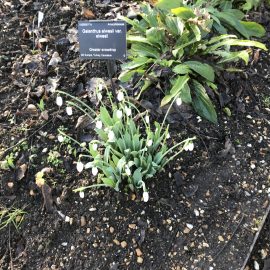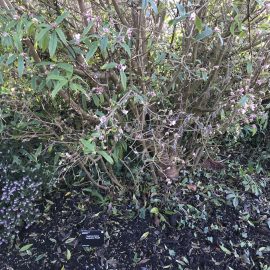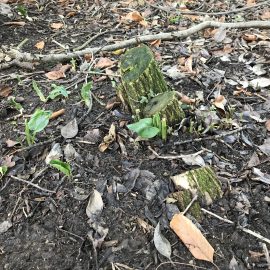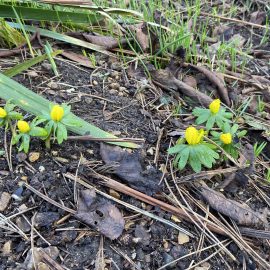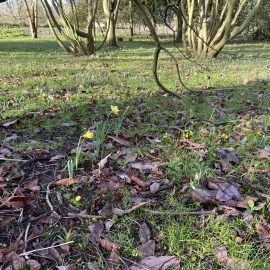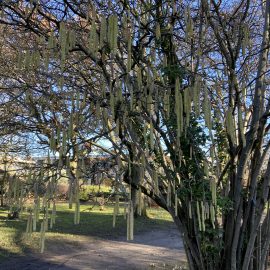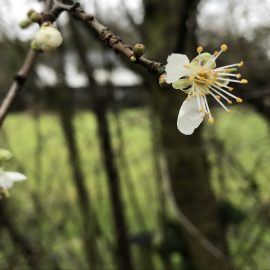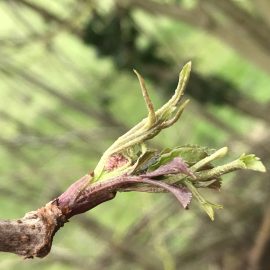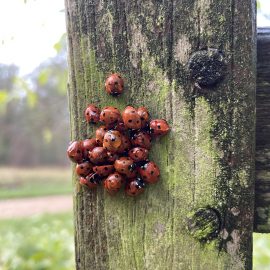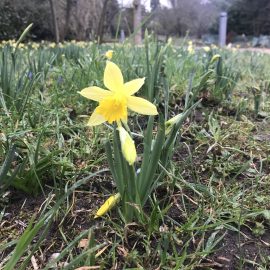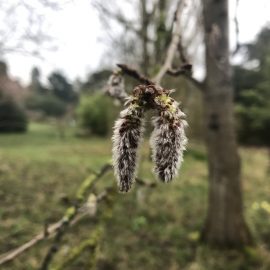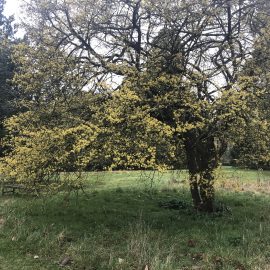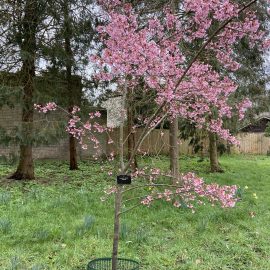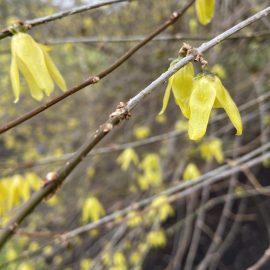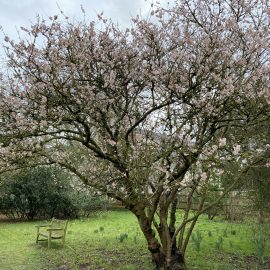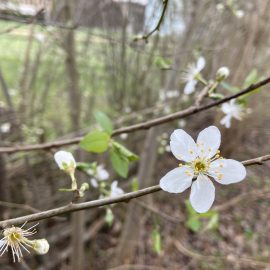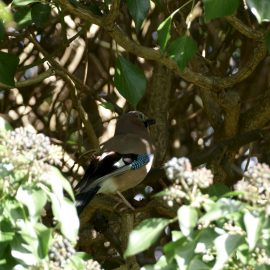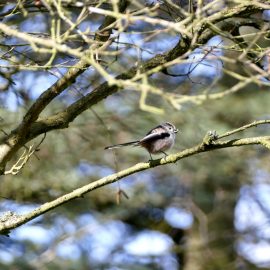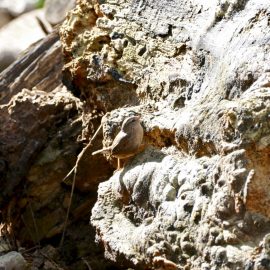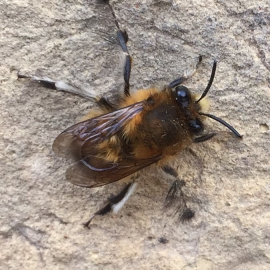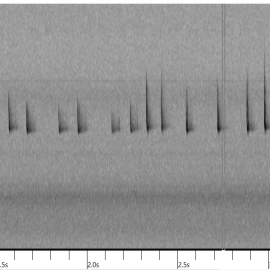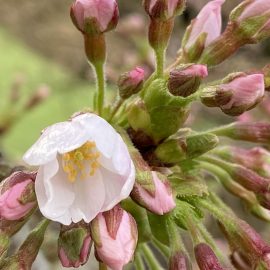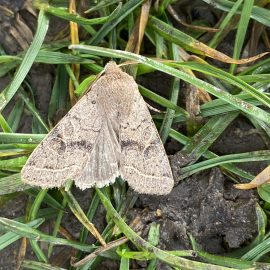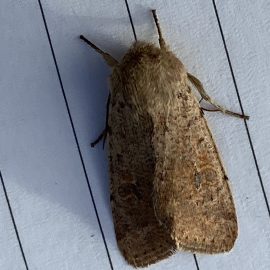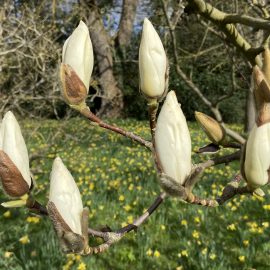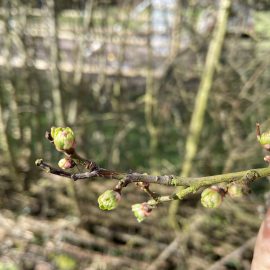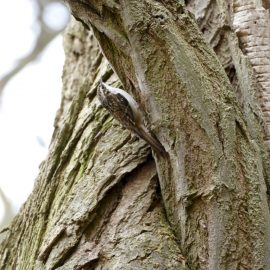Welcome to Wildlife Diaries. We aim to share the wildlife of the Garden as spring arrives. Why don’t you join us and record the wildlife in your garden or patch? You can submit your sightings to Nature’s Calendar and help scientists understand how climate change is affecting the timing of spring events.
We have been inspired by the naturalists of the past – Charles Darwin, Gilbert White, Leonard Jenyns – who kept journals of their observations of the natural world.
7 January 2021
“It’s the middle of winter, but the signs of new life are already in the Garden. Some of our Snowdrops have already burst into bloom, with Galanthus elwesii var. elwessi being amongst the first . The heady scent of the winter flowering Sweet Box Sarcococca confusa and Daphne ‘Jacqueline Postill’ fills the air as you enter the Garden from the Brookside entrance. In the wilder area near the Cambridge Oak, there are buds on the primroses waiting to welcome in the spring and the Lords and Ladies are poking the tips of their leaves through the surface of the soil.”
22 January 2021
“The Winter Aconites are out along with a few Daffodils! The Hazel trees are covered in catkins. We’ve put out a wildlife camera in the Garden to see what’s about at night. Although it’s still cold, the Badgers are active every night. They don’t hibernate, but they may be inclined to sleep more when the weather is particularly bad and the ground is too hard to dig for earthworms which is their favourite food.”
18 February 2021
“The snowdrops are out in their full glory carpeting the Garden in white. They aren’t the only flowers to be in bloom. Primroses and Daffodils add splashes of spring colour. A mixture of Daffodils, Snowdrops and Winter Aconite cover the ground beneath the bare trees along the western boundary. The first Cherry Plum (Prunus cerasifera) blossom has appeared in the Cambridge Hedge near the café! Leaves are also beginning to burst from their buds on some branches. Elder (Sambucus nigra) has just done so and is usually one of the first native tree species to burst its buds. We’ve also spotted hibernating Seven-spot Ladybirds all over the place, often in quite large groups, sometimes in quite exposed locations like the edges of benches or in the foliage of herbaceous vegetation. The birds are singing in the February sunshine, from Robins defending their territories to the trills of the Wren skipping in the wood pile and the insistent ‘teacher-teacher’ call of the Great Tits. We heard the first Song Thrush of the year singing back in mid January, but now they are much more vocal, repeating the same sounds two or three times in succession.”
25 February 2021
“As the Snowdrops start to wind down, the Daffodils take over the show and they now cover the ground beneath the trees, most of whom are still naked. The first furry catkins of Aspen (Populus tremula) were spotted today! The grove of Cornelian Cherry trees (Cornus mas) near the Cambridge Oak are now in full bloom, with clusters of tiny bright yellow flowers delighting visitors and providing a food source for the Great Tits who are starting to check out potential nesting spots.”
2 March 2021
“From the pale pink blossom of the Sweet Almond to the boughs of yellow on the Forsythia, splashes of colour can be found around the garden. And it is not just the humans that are enjoying the spring blooms, as bumblebess buzz from flower to flower. In the early evening, Tawny Owls can be heard calling to each other.”
5 March 2021
“Things are really starting to take off! More and more trees are awakening, many of the Prunus trees in the Garden are now in blossom, we await with baited breath for the spectacular Yoshino Cherry (Prunus x yedoensis) on the main lawn to burst into blossom, could it be next week? It’s the iconic spring sight in the Garden and the date of first blossoming is a special occasion. Bird song is starting to really pick up, with robins, blue and great tits, wrens, blackbirds, song thrushes, coal tits and others all singing their hearts out. It’s the males singing for a mate. We were really excited to spot the first flower of Purple Toothwort (Lathraea clandestina) today, poking its head above ground near the lake! Its a root parasite and the only time you know it’s there is in the spring when it flowers. We think this one may be parasitising the roots of the nearby Willow trees (Salix sp.).”
9 March 2021
“Sunny spells in the garden saw white butterflies flitting in the bee borders, and bumblebees buzzing as they collect nectar. The long-tailed tits are active, feeding and building a nest. The air is filled with the sound of robins, blackbirds probe the softer ground for worms to eat, and blue tits and great tits glean food from tree branches. More buds are getting ready to burst with leaves and blossom, and green shoots from the ground and getting stronger. The water in the garden is coming to life, with small water boatmen darting beneath the surface.”
12 March 2021
“After an extremely windy few days which resulted in the Garden being closed to visitors yesterday, wildlife has hunkered down again, waiting for some more settled weather. Despite the breezy conditions the badgers have been active at clearing out their setts. You can see from the video taken by one of our wildlife cameras last week that they are really busy digging out used bedding. We also had a bat detector out overnight recording the high frequency sounds that bats make. Bats hibernate in winter but will come out to feed when temperatures get above 8 degrees Celsius. Below is a sonogram of a Soprano Pipistrelle flying over the lake last night. Each bat has a unique call signature and we can use these sound recordings to work out which species are using a site. This bat must have been hungry! Some lovely male hairy footed flower bees were also spotted today by one of our visitors, females emerge a few weeks later. These are our favourite bees at this time of year, they are so cute. Just look at those hairy legs! We’ll be looking out for their nests now. A pine ladybird, with its red comma like spots on a black body, was also spotted in the leaf litter still hibernating.”
17 March 2021
“After a dull start to the day, the sun came out. A Goldfinch greets visitors at the gate with its babbling song. A Smooth Newt makes an appearance swimming in the Fen Display, and the nearby Winter Garden looks and smells glorious in the late afternoon sunshine. Bumblebees buzz around the flowers collecting nectar. Our first Red Tailed Bumblebee was spotted feeding on the Mahonia flowers. Magpies, Longtailed Tits and Blackbirds were seen gathering nesting materials, and the air is filled with a chorus of Robins, Blackbirds, Wrens and Great Tits.”
19 March 2021
“Finally a gloriously sunny day! Chance for some of the early emerging insects such as spring moths and queen bumblebees to warm up and do some foraging. We checked the moth trap first thing to see which moths we had caught. We have been moth trapping almost every week since March 2018- we even trap throughout the winter. The data contributes to the National Garden Moth Scheme. Since January we’ve had very few moths in the trap, some days nothing, but this morning we had eight! Wow! This pales in comparison with the hundreds of moths we catch in June and July, but we were nevertheless very chuffed to have this many, after having such low numbers for so long. We caught a Small Quaker (which we think is a first for the site), five Common Quakers and two Hebrew Characters. Moths have such quirky names! The Yoshino Cherry has one or two blossoms and the rest are imminent, we can’t wait for the spectacular display we know is coming. Last year it was in full bloom by now, so spring is a bit slower this year, but it’s almost here! The Magnolias near the Brookside Gate are also about to burst into bloom. We’ve also started looking at the swelling buds on the native plants in the Cambridge Hedge and they are absolutely beautiful. The intricate detail of each bud, about to burst into leaf, is well worth a closer look. The Blackthorn in the hedge has just started to blossom too, overlapping with the blossoming Bird Cherry in the corner, which is unusual. Last week, a visitor spotted a Treecreeper (a rather shy bird that does as its name suggests), and sent in the lovely photo below. Another was spotted in the birch trees by the fountain today.”


